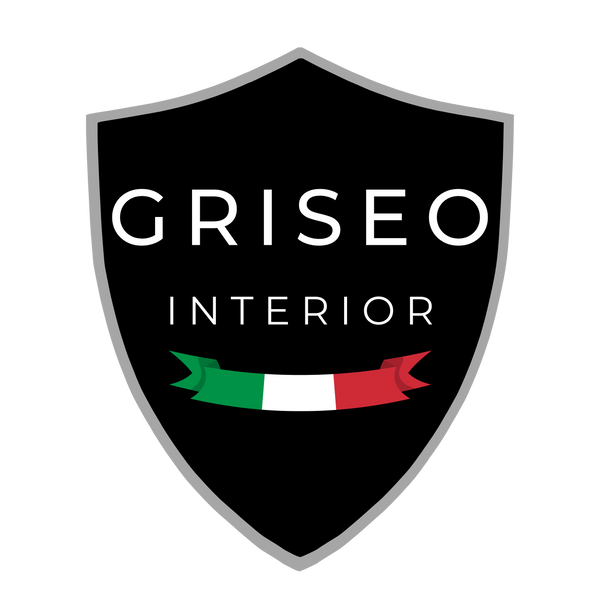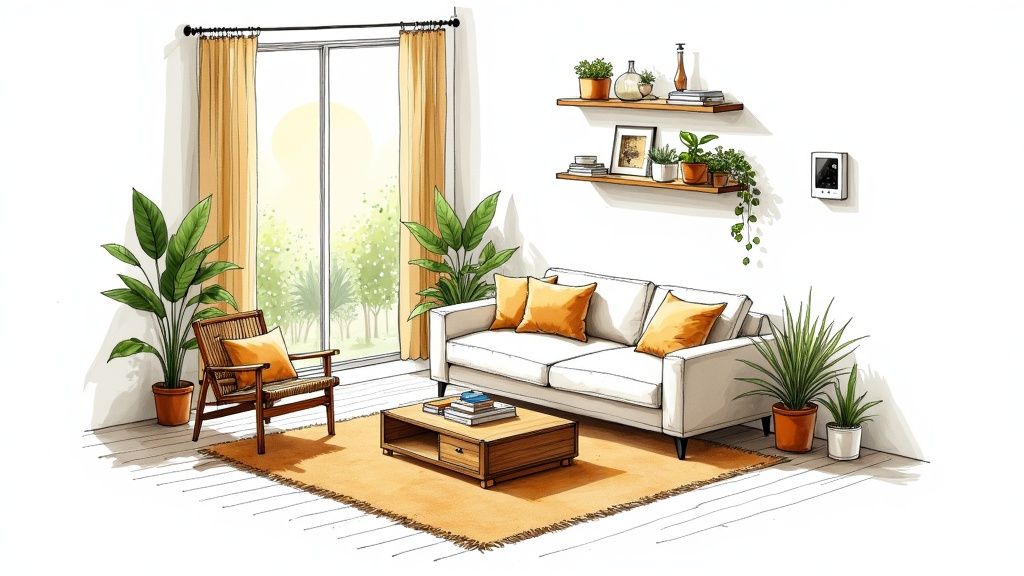
A Practical Guide to Eco Friendly Interior Design for a Better Home
Creating a home you love is a special kind of joy. When that home is also kind to the planet, the feeling is even better. Eco friendly interior design isn't just a trend; it's a practical approach to living that combines beautiful style with sustainable substance.
Why Conscious Design Choices Matter More Than Ever
Let's bust a myth right now: going green doesn't mean sacrificing style. In fact, it's the opposite. Embracing sustainable design opens up a world of authentic, long-lasting, and incredibly personal spaces. Every choice—from the paint on your walls to the fabric on your sofa—helps cultivate a healthier home for you and a healthier world for us all. This isn't a niche movement anymore; it's becoming a global standard for good living.
The booming sustainable home decor market tells this story loud and clear. Currently valued at around USD 4.5 billion, it's projected to more than double to an incredible USD 9.4 billion by 2034. That's powered by a strong 7.9% compound annual growth rate, fueled by our collective desire for healthier living spaces and a shift toward functional, minimalist design that just makes sense.
If that less-is-more philosophy resonates with you, our guide on minimalist home decor ideas is a great place to start your journey. You can also discover more insights about the sustainable home decor market to see just how big this movement has become.
The Real Impact of Your Choices
Making conscious design choices delivers real, tangible benefits. These decisions directly lead to lower carbon emissions, cleaner indoor air, and a massive reduction in landfill waste.
An eco-friendly home isn’t about perfection; it’s about intention. Every sustainable choice, no matter how small, is a step toward creating a space that nurtures both your well-being and the planet's health.
The data below shows just how powerful these choices are. From cutting CO₂ emissions by using recycled materials to drastically improving air quality with low-VOC paints, the impact is undeniable.
As you can see, simply being thoughtful about the materials and finishes you bring into your home leads to significant environmental and health wins.
More Than Just Materials
At its heart, eco friendly interior design is about weaving a meaningful story throughout your home. It’s about picking pieces built to last a lifetime, supporting artisans who practice their craft responsibly, and designing a sanctuary that truly reflects your values. This philosophy means turning away from disposable trends and investing in quality. The result? Interiors that aren't just beautiful, but are also deeply and authentically you.
Building Your Sustainable Material Palette
The core of an eco-friendly home is in the materials you choose. This is where your vision for a conscious space becomes a reality, built into the very textures that surround you. The goal is to create an environment that feels as good as it looks. Let's get practical about the best sustainable options.
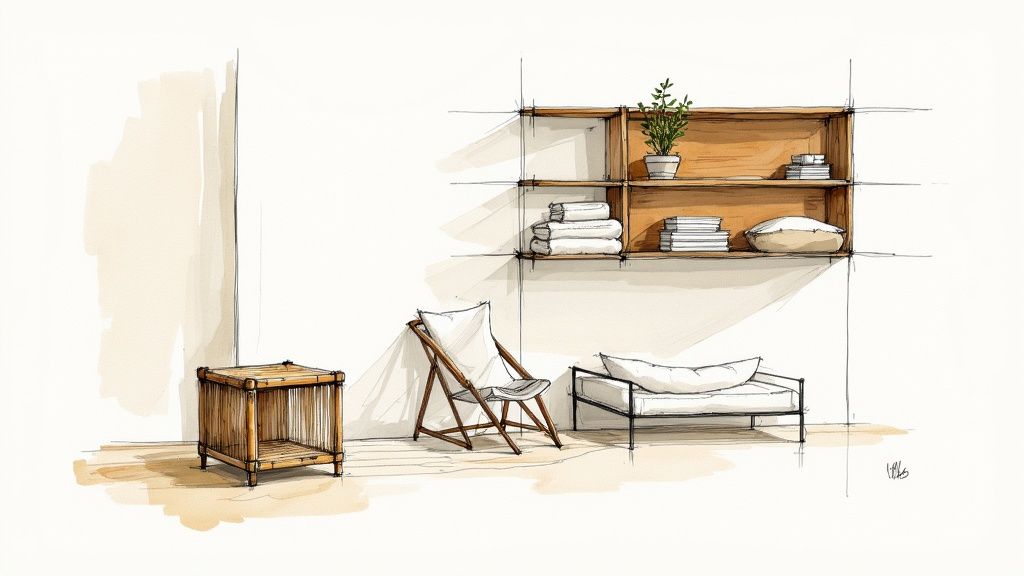
Imagine a dining table crafted from reclaimed wood, where every knot tells a story. Picture walking barefoot on a warm cork floor that softens your steps and insulates your home. These are not just materials; they are choices that infuse your space with character and integrity.
Earth-Friendly Foundations: Wood, Bamboo, and Cork
For wood, the key is the source. Look for FSC (Forest Stewardship Council) certification to ensure the timber came from responsibly managed forests. Even better, choose reclaimed wood. Salvaged from old barns or industrial buildings, it prevents beautiful material from going to landfill and brings unmatched history into your home.
Bamboo is another hero in eco friendly interior design. As a fast-growing grass—some species grow three feet in a single day—it's an incredibly renewable resource. It’s also durable, making it a fantastic choice for modern flooring and furniture.
Cork is a powerhouse material. It’s harvested from the bark of the cork oak tree without harming the tree itself. It's naturally antimicrobial, fire-resistant, and a brilliant insulator for both sound and temperature, making it perfect for creating a quiet bedroom or a warm playroom floor.
Your material choices are your home's vocabulary. Selecting sustainable options like reclaimed wood or fast-growing bamboo allows you to tell a story of responsibility, beauty, and connection to the natural world.
Conscious Comforts: Textiles and Surfaces
The fabrics in your home have a massive impact on its health and environmental footprint. Here are some actionable choices for comfortable, natural textiles:
- Organic Cotton: Grown without pesticides and synthetic fertilizers, it's a healthier choice for you and the planet. Action: Look for the GOTS (Global Organic Textile Standard) certification label.
- Linen: Made from the flax plant, linen requires very little water and pesticides. Its relaxed texture adds effortless elegance to any room.
- Hemp: This durable fiber is naturally pest-resistant, creating a strong, long-lasting fabric that gets softer with every wash.
For surfaces, think outside the box. Recycled glass can be transformed into a stunning kitchen backsplash or countertop. Old metal can find new life as a striking light fixture or unique cabinet hardware, adding an industrial-chic vibe. New technologies are also emerging—learn more in our article on 3D printed home decor.
Comparing Popular Sustainable Materials
This table offers a quick-reference guide to the benefits and best uses of common eco-friendly materials for your home.
| Material | Key Benefits | Best For |
|---|---|---|
| Reclaimed Wood | Reduces waste, rich in character and history, durable. | Feature walls, dining tables, shelving, flooring. |
| Bamboo | Highly renewable, grows incredibly fast, strong and durable. | Flooring, furniture, kitchenware, cabinetry. |
| Cork | Harvested without harming the tree, excellent insulator, soft underfoot. | Flooring (especially in bedrooms/playrooms), wall tiles. |
| Organic Cotton | Grown without pesticides, soft, breathable, hypoallergenic. | Bedding, upholstery, curtains, towels. |
| Linen | Requires minimal water/pesticides, durable, gets softer with use. | Curtains, tablecloths, bedding, upholstery. |
| Recycled Glass | Diverts waste from landfills, unique aesthetic, non-porous. | Countertops, backsplashes, tiles. |
Choosing the right materials is about more than aesthetics; it's about building a space that truly reflects your values. By intentionally selecting these materials, you create a space that’s not just visually stunning but is also deeply aligned with what you believe in.
Furnishing Your Home with Heart and Intention
The furniture and decor you choose give your home its soul. It's about curating a space with purpose, bringing in pieces that tell a story. Let's look at actionable ways to find beautiful, sustainable furniture that elevates your home.
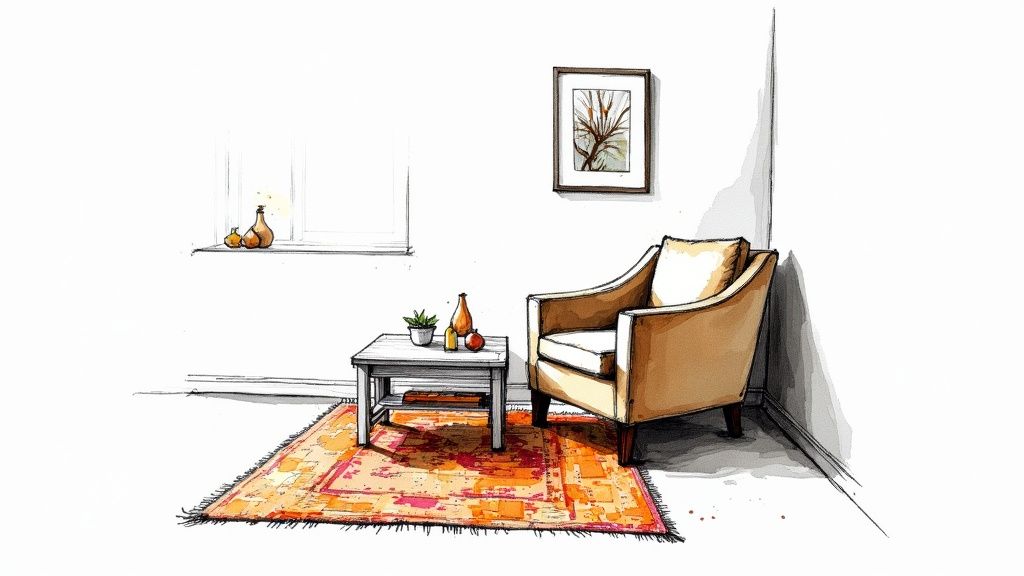
Choosing to furnish with intention is part of a huge global shift. The eco-friendly furniture segment was recently valued at an incredible USD 43.26 billion and is on track to grow by 8.6% every year until 2030. People are demanding products made with recycled materials and natural fibers. This move toward conscious consumerism is reshaping the design world, and you can see the data on these market trends for yourself.
The Thrill of the Secondhand Find
Before buying new, embrace the hunt for secondhand treasures. Antique shops, flea markets, and online marketplaces are full of unique pieces with history and character. A solid wood dresser from a bygone era is almost always better made than its modern, flat-pack cousin, and you’re keeping a beautiful item out of a landfill.
Action Plan: Look past surface flaws. If a piece has a sturdy frame and classic shape, it’s a perfect candidate for a refresh. A fresh coat of low-VOC paint, new hardware, or reupholstery can transform a forgotten item into the star of your room.
Embracing a 'less but better' philosophy is really the heart of sustainable furnishing. It’s not about deprivation, but about being incredibly selective. One beautifully crafted, pre-loved piece can bring more soul and personality to a room than a dozen mass-produced items ever could.
This mindful approach leads to a calmer, uncluttered home. You end up surrounded only by things you truly love, creating a sanctuary that feels both personal and serene.
Buying New with a Clear Conscience
Sometimes you need to buy new. When you do, be a smart consumer. The goal is to support brands that value transparency, craftsmanship, and ethical production. Here’s a checklist for buying new furniture:
- Check Certifications: Look for the FSC (Forest Stewardship Council) logo on wood products. For textiles, seek GOTS (Global Organic Textile Standard) or OEKO-TEX labels.
- Demand Transparency: Does the company openly share its supply chain and manufacturing process? Ethical brands make this information easy to find.
- Inspect Construction: Look for quality joinery (like dovetail joints) instead of just glue and staples. A well-built piece is an investment that can last for generations.
The Finishing Touches
Apply the same intention to your decor. Instead of generic accessories, seek out items with meaning. Action: Find small, handcrafted items from local artisans, vintage pottery at a flea market, or natural elements like interesting branches or stones to bring an organic feel to your space. For more ideas, explore our guide on eco-friendly home accents. Furnishing your home this way creates a haven that truly reflects your values.
Creating a Healthy and Energy-Smart Home
A sustainable home actively boosts your well-being while shrinking its environmental footprint. It's about smart design choices that create comfort and long-term energy savings. The goal is to build a home that works smarter, not harder.
It begins with harnessing the natural rhythm of the day. Strategic room arrangement can dramatically cut your need for artificial lighting and heating.
Let the Sun and Fresh Air In
Before you install a light fixture, analyze your floor plan. Action: Position rooms where you spend daylight hours, like your home office or living room, to receive the best natural light. You can amplify that light by using lighter wall colors, placing a mirror opposite a window, and choosing sheer curtains to make any room feel brighter.
This isn't just aesthetic; it’s about energy savings. More daylight means flipping fewer switches, which directly lowers electricity bills.
A smart home isn’t just about technology; it’s about a thoughtful partnership with nature. Letting the sun light and warm your space is the simplest, most effective form of energy efficiency there is.
Clean Up Your Indoor Environment
The air inside our homes is often more polluted than the air outside, largely due to chemicals called VOCs released from paints, finishes, and cleaning products. One of the most impactful changes you can make in your eco friendly interior design journey is choosing healthier materials.
Action: When you repaint, choose low-VOC or zero-VOC (Volatile Organic Compound) paints. These formulas drastically reduce harmful off-gassing, letting your family breathe easier.
Bring in nature’s own air purifiers. Houseplants are phenomenal at filtering toxins. Here are three powerhouse plants to start with:
- Snake Plant (Sansevieria): Nearly indestructible, it’s a star at converting CO₂ into oxygen at night.
- Spider Plant (Chlorophytum comosum): A champion at removing formaldehyde and xylene.
- Peace Lily (Spathiphyllum): Its beautiful white blooms come with the benefit of filtering ammonia, benzene, and formaldehyde.
Make the Switch to Energy-Smart Technology
Intelligent upgrades to your home's systems are a cornerstone of modern sustainable living. These investments often pay for themselves through lower utility bills.
Actionable Steps:
- Switch to LED Bulbs: If you haven't already, replace old incandescent bulbs with LEDs (Light Emitting Diodes). They use up to 85% less energy and can last 25 times longer.
- Install a Smart Thermostat: These devices learn your routines and adjust the temperature automatically, so you're never wasting energy heating or cooling an empty house.
- Seal Drafts: Pair a smart thermostat with good insulation and draft-proofing around windows and doors to create a home that’s both comfortable and incredibly efficient.
Bringing the Outdoors In with Biophilic Design
Have you ever noticed how a walk in the woods can reset your state of mind? That’s because of our innate connection to the natural world. Biophilic design is the practice of intentionally weaving nature into our homes to improve our health and happiness. It’s about creating spaces that feel alive.
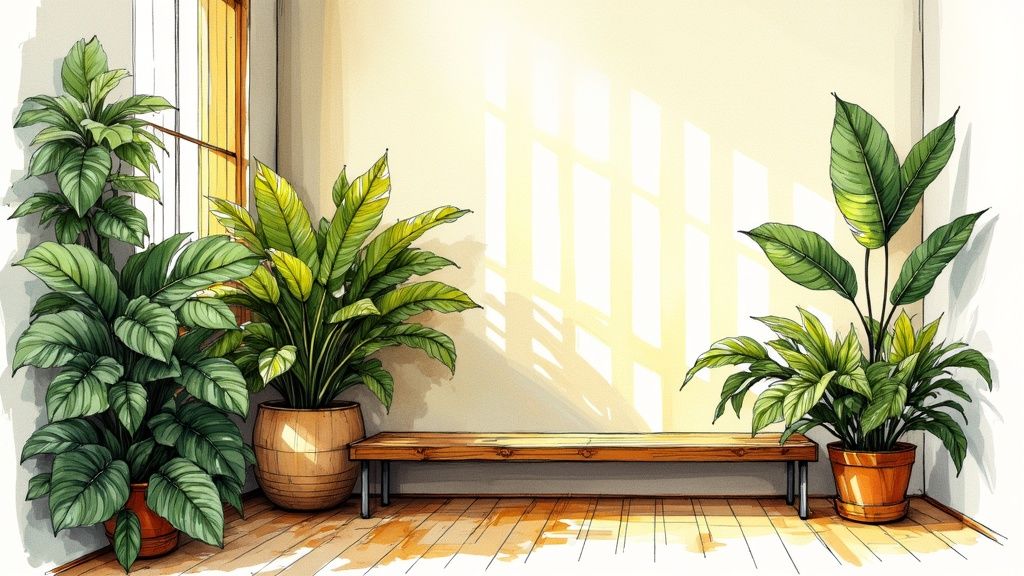
This philosophy is part of a bigger movement. The global interior design market is projected to surge from USD 138.63 billion to over USD 208.16 billion by 2033. A huge part of that growth comes from demand for homes that are more sustainable and centered on wellness, as reflected in earthy 2025 design trends.
It’s So Much More Than Just Houseplants
Adding a few plants is a fantastic first step, but true biophilic design goes deeper. The goal is to mimic the experience of being in nature—its patterns, textures, and calming sensations. It's about creating a fully immersive environment.
Biophilic design is our inherent need to connect with nature, spoken in the language of interior design. The goal is to create spaces that don't just look natural, but truly feel natural, helping to melt away stress and bring a deep sense of calm.
Think about drawing your color palette from a misty forest or a sun-drenched beach. Incorporate materials that feel good to the touch, like rough-hewn wood or cool, smooth stone. Even arranging a chair to face a window can make a difference.
Practical Ways to Welcome Nature Inside
Bringing this philosophy home doesn’t have to be complicated. The magic happens when you create subtle, consistent touchpoints with nature in your daily life. Here are a few simple actions you can take:
- Maximize Light and Air: Keep windows clear of heavy drapes to let sunlight stream in. Whenever possible, open them up to allow a fresh breeze to circulate.
- Embrace Imperfect Shapes: Nature rarely uses straight lines. Look for furniture and decor with softer, organic curves, like a live-edge coffee table or a sofa with flowing lines.
- Engage All the Senses: Add the sounds and smells of nature. A small indoor water fountain can provide the soothing sound of a brook. Natural wood or beeswax candles can fill your space with a subtle, earthy scent.
When you bring these elements into your home, it transforms from a simple shelter into a restorative sanctuary that actively supports your well-being.
Got Questions About Sustainable Design? Let's Talk.
Starting with eco friendly interior design is an exciting journey, but it's normal to have questions. Let's tackle some of the most common ones to help you begin with confidence.
Isn't Eco Friendly Interior Design Just More Expensive?
This is the biggest myth out there. While some new sustainable materials can have a higher upfront cost, many eco-friendly choices actually save you money. Thrifting a solid wood dresser, choosing durable materials that last a lifetime, and designing for energy efficiency all lead to long-term savings on replacements and utility bills. The real goal is to invest in quality and timeless style, not chase fast-fashion trends for your home.
Sustainable design isn’t about spending more; it's about spending smarter. By focusing on durability, timelessness, and resourcefulness, you create a home of lasting value that aligns with your budget and your principles.
Okay, So Where Do I Actually Find Sustainable Furniture and Decor?
Once you start looking, you’ll see opportunities everywhere. Here’s where to start:
- Antique Stores & Flea Markets: These are goldmines for unique, well-crafted furniture with a story.
- Online Marketplaces: Use sites for secondhand goods to find pre-loved items from people in your neighborhood.
- Local Artisans: Visit a local craft fair or an artist's studio to discover beautiful, handcrafted pieces made with sustainable practices.
If you're buying new, choose brands that are transparent about their manufacturing. Look for certifications like FSC on wood or GOTS for textiles—these are your proof of a responsible company.
What's the Easiest Way to Just Get Started?
Don't try to do everything at once. Start with one small, simple step to build momentum.
Actionable First Steps:
- Swap a Light Bulb: The next time a bulb burns out, replace it with an energy-efficient LED.
- Choose Better Paint: Planning to repaint? Select a low-VOC or zero-VOC paint for better indoor air quality.
- Add a Plant: Bring home an air-purifying plant like a Snake Plant or Spider Plant. They look great and clean the air.
Perhaps the simplest step is a shift in mindset: before you buy anything for your home, ask yourself, "Do I really need this? Is there a more sustainable way to get it?"
Ready to bring intentional, sustainable beauty into your home? Discover the essence of modern Italian craftsmanship with Griseo Interior. Our collection of minimalist vases and decor is crafted on-demand, blending timeless design with a commitment to reducing waste. Explore our pieces and find the perfect accent for your conscious home.
